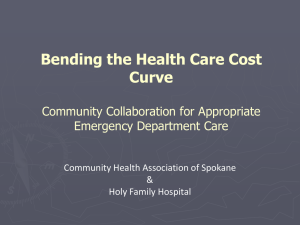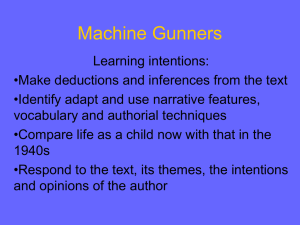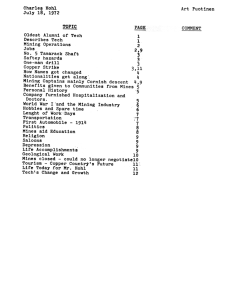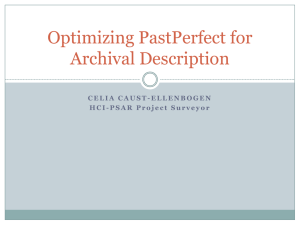Strengthening Health Systems Through the Use of Community
advertisement
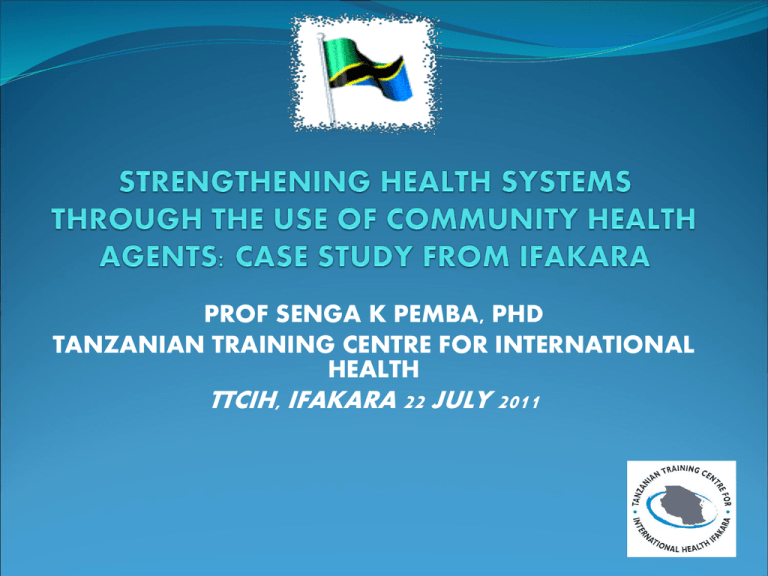
PROF SENGA K PEMBA, PHD TANZANIAN TRAINING CENTRE FOR INTERNATIONAL HEALTH TTCIH, IFAKARA 22 JULY 2011 Introduction Despite an increase in health spending in Africa, many people have limited access to good quality health care, especially in remote and rural areas. The burden of diseases such as HIV, TB and malaria, lack of health workers and management and organisational failures are all attributed to weak health systems in these countries WHO’s view of a health system According to the World Health Organization (2000) a health system is “all activities whose primary purpose is to promote, restore, and maintain health.” However, in recent years, the definition of “purpose” has been further extended to include the prevention of household poverty due to illness. Thus: “all activities whose primary purpose is to promote, restore, and maintain health including the prevention of household poverty due to illness.” Enabling sub-system inputs… …generate system outcomes… Integrated service components Health workforce size, composition & training Information for decision-making Essential drug supply & logistics Enhanced access to services and technologies Extended range of services and technologies Health financing & resource allocation Improved quality of services Leadership & governance Improved efficiency Effective Health System …that alter the climate of demand for services …impact on health behavior, and …. Improved equity Enhanced Health Service Utilization Reduced social costs Source : IHI Improve survival The focus of an effective health system The key functions of a health system as earlier on discussed focus on: Health service provision, Ensuring Human Resources for Health (with the requisite skills, in correct numbers, skills mix) are available Ensuring Information for planning and decision making is in place Ensuring medical products, vaccines and technologies are in place Stewardship Health financing Households’ demand and behavior largely determine how these functions perform. Key functions of a health system ctd… In order to strengthen a health system you need to ensure that the needs of the poor and vulnerable communities are adequately addressed. The 1978 Declaration of Alma Ata recognises the Community as part of a health system You can therefore only effectively address population health needs and burden of disease if policies can focus on health services provided at the community level. We need a Health system that cares The case of Tanzania • Tanzania is making progress towards MDGs but mortality is still too high: • MMR: 578 per 100,000 live births • U5MR: 112 per 1000 live births • NMR: 32 per 1000 live births • Community and health system linkage is weak • Coverage of cost-effective interventions is low • Current coverage levels not sustainable Coverage of Selected Cost Effective Interventions 2010 Source Shoo & Mzige 2010 96 93 84 88 57% 57 64 53 51 41 27 24 0 Key questions on the health system… • The key questions which require urgent answers are: • How to best deliver integrated MNCH package? • How to increase demand and utilization? • How to maximize the impact of these interventions? 10 Some practical solutions! There are however, practical/affordable health interventions that are available! Providing effective health extension to communities and households Supporting the government to strengthen Community Health work as articulated in the Primary Health Services Development Plan of 2007, the RCH Roadmap and the Human Resource Development Strategy. All the above can be achieved through the use of Community Health Agents A Quote to start with…. “Essential health services cannot be provided by people working on a voluntary basis if the services are to be sustainable. While volunteers can make a valuable contribution on a short-term or part-time basis, trained health workers…should receive adequate wages and/or other appropriate and commensurate incentives”. Task shifting: rational redistribution of tasks among health workforce teams [Global recommendations and guidelines, recommendation 14]. Geneva: World Health Organization; 2008. Trained and paid health workers are key Who is a Community Health Agent (CHA)? A CHA is a health worker, selected by the community where he/she lives, formally trained and works in his/her own community performing a diverse range of roles and activities CHAs have the capability to reach out to rural communities/households facing major barriers in accessing health services In carrying out such duties, CHAs are assisted by Enrolled Nurses, Health Assistants, Clinical Assistants, Clinical Officers and other social workers Over the past one year the Tanzanian Training Centre in International Health Ifakara has embarked on training this cadre of CHAs Locations where CHAS will work Kilombero and Ulanga in Morogoro Rufiji in Coast Region 15 Evidence base in support of CHA 1. Community and HH based interventions have 61% 2. 3. 4. 5. impact on mortality Integration of services is more efficient and cost effective Most interventions that reduce mortality and morbidity can be delivered at community level using CHAs CHAs have been found to effectively promote the uptake of interventions at the community level. It is much easier and less costly to train a CHA than other health professionals who take many years of training but also unwilling to work in rural communities How different health workers fit in a health system Source: WHO 2000 Where do CHAs fit in the health system? ctd… The appropriate location for Community health Agents is at the community level just like what the pyramid shows At this level CHAs bridge the gap between health facility and the house hold They in addition form part of the referral system It is on this basis CHAs are considered and recognized as an integral part of the health system CHAS within the TZ health system The training of CHAs is part of an intervention study under the Ifakara Health Institute (Connect project) to introduce a formally trained and paid multi tasked CHA linked with a District wide Emergency Referral System This intervention will Strengthen the health system by way of providing a link between the health facilities and villages/households by providing the right type of HRH to facilitate accessibility of information, medicines and supplies, improving organization of work from the community-level up, including timely emergency referrals Design of the CHAs training programme The CHAs training curricular is deigned on the principles of Competence based education It is a one academic year (36 Weeks) programme divided into two levels: National Training Award (NTA) Level 4 and 5. NTA Level 4 has a total of 18 weeks divided into two semesters of nine weeks each Similarly, NTA Level 5 has also 18 weeks divided into two semesters of nine weeks each There is field work during NTA Level 5 of 4 weeks which is implemented in the Villages where the trainees came from. Design of the CHAs training programme ctd... Each session has a module specifically developed for that session. The modules are important in guiding trainers on what to teach and assess IMCI and Community IMCI are among the sessions covered during the course. IMCI is an important component in assisting CHAs to manage childhood illnesses During the training phase, the Supervisors for CHAs are mainly the trainers though Village leaders have to oversee the trainees performance in the field Training of CHAs: what and how was it done? Training Needs Assessment (TNA) was successfully completed using a variety of methods and tools An occupational profiling of existing community health workers was conducted to identify the appropriate competencies for the new cadre of CHAs Based on the competencies derived, development of a competence based curriculum was then undertaken using experienced medical educators. Training of CHAs: what and how was it done? ctd… Development of relevant training modules was also undertaken using a team of experts Orientation of trainers for the CHAs was conducted by experienced Master Trainers Recruitment of 58 trainees in collaboration with Villages was successfully done Delivery of CHAs training programme started in October 2010 CHAs field work was successfully done in April/May 2011 Training of supervisors (technical and community) was successfully done 1st batch of CHAs (57) graduated in July 2011 and are now back to their home villages ready to provide service Roles of CHAS 1. 2. 3. 4. 5. Conduct households baseline data collection, update Village Register, routine household visits Routine distribution of key household health “technologies”/commodities that prevent illnesses Health education, counseling on key aspects of general health Mobilize for birth planning, facility delivery, post partum visits and care for mothers and newborns Early treatment and follow up of children with uncomplicated illnesses Roles of CHAS ctd… 6. 7. 8. 9. 10. 11. 12. Conduct community diagnosis Collaborate and network with other sectors in the community Provide home-based care Promote nutrition at the community level Participate in planning, implementation, monitoring of village activities Participate in disease prevention and control Manage common illnesses Are there opportunities for scaling up CHAs training in TZ? The answer is YES!! 1. Renewed interest globally – WHO, GHWA, UNICEF, etc 2. Institutional and policy frameworks supportive – HRH Strategy ,RCH Roadmap, MMAM 3. Funding opportunities within the fiscal space:District Councils, Cost recovery , CHF etc 4. Widespread use of mobile phones technology – 62% of HH have access. Are there challenges ahead? Many BUT can be solved!! Recognition of the new paid community based health cadre in Health Workers Scheme of Service in Tanzania Payment of the new health cadre Sustainable monitoring and support by the health system to ensure functionality of the cadre: Medicines and supplies Feedback to community and service delivery data collected by CHAs On the job training Maintaining functional linkages with existing community governance and accountability structures END THANK YOU CHAS FOR CARING FOR US!
